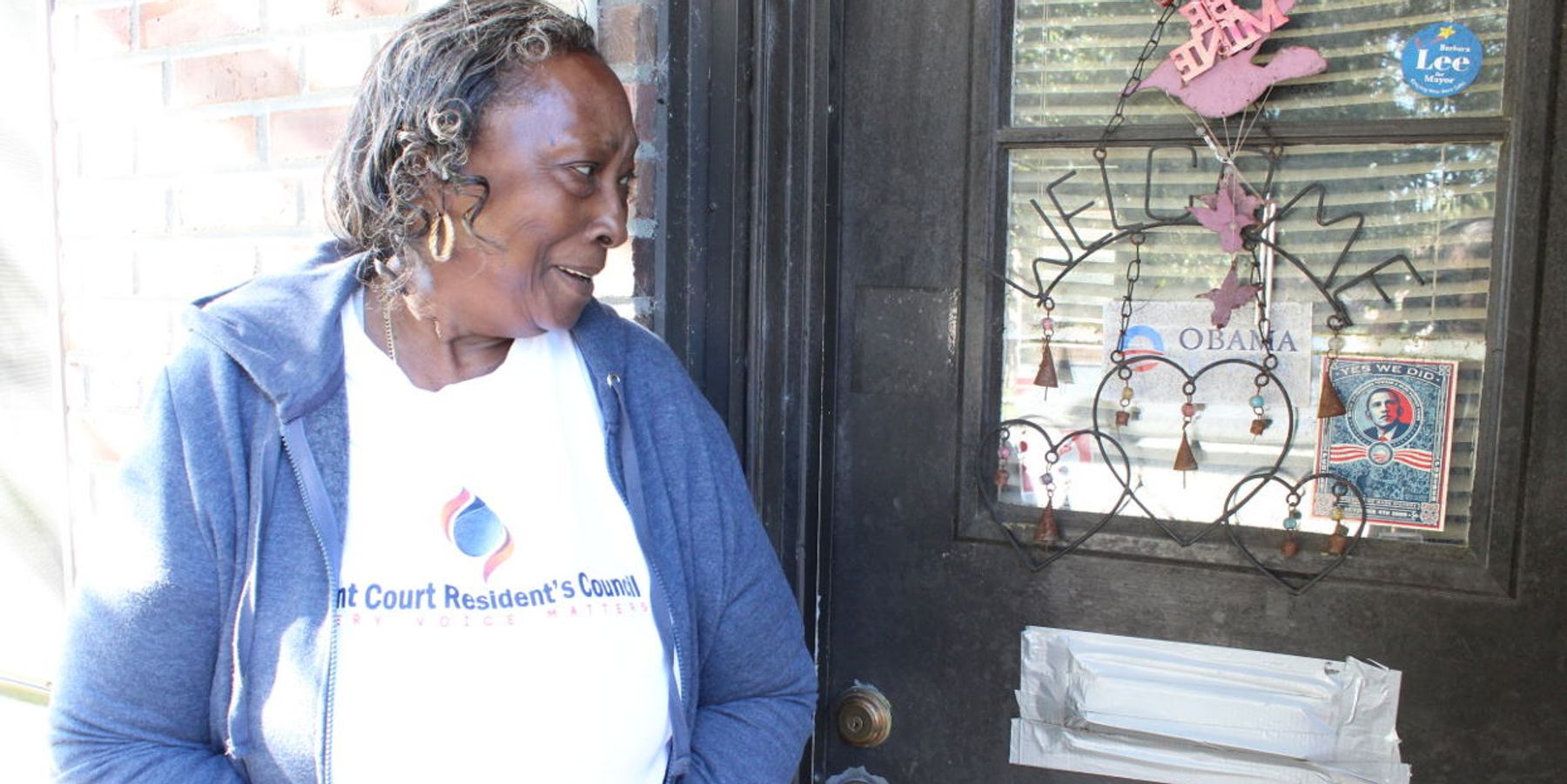
Poor southerners are joining the globe’s climate migrants
This is what climate catastrophe looks like
Editor's note: This story is part of a series examining the social and health injustices resulting from increasingly intense storms and is the result of a collaboration between EHN and Scalawag Magazine, an independent nonprofit magazine that covers the American South.
NEW BERN, NC — Tyechia Buck and her 12-year-old son camped out on the second floor of her townhouse during last September's Hurricane Florence—at least at first. The storm surge Wednesday night was so big it flowed over the banks of the Neuse River before the rain even started here. The town slowly disappeared underwater, starting at the Trent Court housing projects, a small collection of brown brick townhouses.
By 11 o'clock Thursday morning she realized she'd made a mistake not evacuating: waves were lapping up against the building next to hers.
"I went out my back door and didn't look back," she said.
Since then she and her son have been staying wherever: with family, in and out of shelters, in a hotel, and finally back at the apartment in Trent Court. When she came back home, she said, "I turned my key, opened my door, and busted out crying." Her refrigerator was on its side, floating. Everything on the first floor of her two-story public housing unit was destroyed by more than four feet of floodwater.
Buck said she had never seen anything like it. Trent Court, where she was born and raised, is a squat collection of 1940's era brick buildings near where the Neuse River begins to widen into a sound and open up toward the Atlantic Ocean. The silty water overwhelmed Trent Court, and many other parts of New Bern and eastern North Carolina.
Now, the local housing authority has decided that nearly half of the residents of this 80-year-old public housing complex cannot return. Demolition was already in the works at Trent Court, and it's been fast-tracked by the storm. Buck is a "squatter" in her own home, permanently evicted but still living there with no heat or hot water.
Demolition, redevelopment, and an effort to move residents into other affordable housing nearby could take years, by which point, there's no knowing where people will be. And these days, this story of displacement from public housing repeats itself each time hurricane season rolls around: The most notorious case was New Orleans after Katrina, but since then, public housing residents have been pushed out by Ike, Dolly, Harvey, Irma, Matthew, Florence, and Michael—just to name a few.
Public housing residents, along with other poor, disabled, elderly, and vulnerable people, are becoming a first wave of climate migrants in the U.S.—people selectively displaced by increasingly frequent storms and floods, moved because they can't afford to stay. Their forced removal also marks the sputtering end of a long effort to close down the project of government-subsidized housing in this country, leaving affordable housing to the so-called free market.
"From where I sit, this is our Katrina. This is our 9th Ward," said Omisade Burney-Scott, a longtime Durham-based community activist and seventh-generation New Bernian. She's among a group of people in New Bern seeking support for displaced people in the city's historically-Black neighborhoods and public housing units.
Burney-Scott is worried not just about individual displacement, but the displacement of a culture—she's worried Black residents with deep history in New Bern will be replaced by wealthier white people as a result of Florence. New Bern's dense downtown, just across the road from the Trent Court development, is charming and quaint: Victorian-style brick buildings, shops with bells on the door, high property values.
The city itself is 308 years old, and after the Civil War it was part of the district that elected the largest number of Black representatives to Congress during Reconstruction. Its Black community has been strong since before the end of slavery, as it was an early refuge for free Black people.
And yet, New Bern is also home to intergenerational inequities in income and wealth, divides that are exacerbated by disaster. Trent Court, the 218-unit public housing development, is mostly Black even as the city's population is 53 percent white. Burney-Scott, who's been meeting with public officials and residents since Florence, is frustrated that, in her view, after the flood Trent Court was effectively abandoned by the local housing authority.
"They put Trent Court in this weird palliative care kind of situation, just waiting for it to die," she said. "And they're not providing any support for it while it's dying."
A disaster without a plan

Martin Blaney, the head of the New Bern Housing Authority, at a table behind the senior housing complex where he waited out Hurricane Florence. (Credit: Lewis Raven Wallace)
Martin Blaney, director of the New Bern Housing Authority, waited out the storm on the fourth floor of one of the housing authority buildings, New Bern Towers, a home for the elderly just down the block from Trent Court. He didn't want to go back to his home across town for fear of getting stuck there, unable to respond to calls. And he said once the water came into Trent Court, the calls were constant.
"We have a disaster plan, but our plan did not expect the type of devastation that we had," he said, sitting in the sun outside New Bern Towers for an interview. "I guess when they say plan for the worst, you never know."
At the federal level, the need to plan for destruction from catastrophic floods ought to be clear: A 2017 report found that 9 percent of public housing units, and 8 percent of privately owned federally subsidized housing units in the U.S., are in a floodplain—close to a half a million units and some million people. Many residents of government-subsidized housing have already become climate migrants, in New Orleans, Miami, Houston, and Puerto Rico.
Even beyond public housing, the trickle of climate-related migration is already upon us: The Internal Displacement Monitoring Centre estimates that 1.68 million Americans were internally displaced by disasters in 2017.
Another study, from the University of Georgia, predicts sea level rise alone could displace as many as 13 million Americans by the end of the century.
And globally, the World Bank has predicted at least 143 million people will migrate internally in Sub-Saharan Africa, Latin America and South Asia by 2050 as a result of water shortages, rising sea levels, and decreased crop yields tied to global climate change.
Blaney is genial and easy-going, unafraid to answer questions about Trent Court—he says he worked around the clock to locate and find lodging for everyone who was displaced from Trent Court—108 units were flooded, with more than 200 people living in them.
A few people simply dropped off their keys, but everyone else they eventually tracked down and helped move from shelters to hotels or motels, and everyone displaced was able to apply for temporary housing assistance and property loss reimbursements from FEMA.
FEMA treats public housing residents as it would other renters, asking for proof of displacement. But on the HUD side, Blaney says there is no special budget, and no plan, for helping out people suddenly and permanently displaced by flooding or storms.
"We just simply did not expect an event where we would have to tear down the buildings," Blaney said. It came as a shock."
He does say tearing down Trent Court was inevitable eventually because the buildings had become too expensive to maintain. The New Bern Housing Authority relies on HUD funding.
"For years now their support has dwindled, and you know, the older your development, the more it costs to maintain it," he said. With HUD cutting funds for both general operating and capital improvements, keeping up with Trent Court was impossible.
Anticipating this, the New Bern Housing Authority got a HUD grant a few years ago to create a redevelopment plan for Trent Court; that plan, which was developed in collaboration with housing residents and New Bern's political leaders, called for Trent Court to be demolished, and replaced with new affordable housing units in other parts of New Bern, a process the housing authority began over the summer. Following a national trend, those housing units would be part of mixed-income developments with significant private funding and private management.
But while HUD funded the planning grant, the federal agency had not yet provided additional funding for demolition and redevelopment. Getting rid of 12 buildings at Trent court will cost $50,000-60,000 per building.
Now, as a result of Hurricane Florence, the housing authority will demolish the buildings at Trent Court anyway, without a timely replacement plan—demolition is expected in 2019, while new housing may not be built for many years. Blaney is working with the city to acquire a piece of land for one of the new mixed-income developments, but 2019 will be spent trying to secure tax credits from the state just to start the work.
"It's gonna be too long for some folks, I'm sure," Blaney said. "It's been too long for a lot of them."
"Public housing is a dying business"

(Credit: Lewis Wallace)
HUD's vision for decades now has been to shutter aging public housing developments like Trent Court, and build new, mixed-income housing in their place. Of 1.4 million public housing units built in the 20th century, only around 1 million remain.
"Public housing is a dying business," Blaney said, shaking his head.
A HUD program called Hope VI demolished nearly 100,000 units of public housing from 1993-2010, replacing just 57 percent of them in new developments.
The demolition and redevelopment process has often been met with resistance from residents; HUD has justified the demolitions on the basis that public housing as it was envisioned in the 20th century has become dangerous and unsustainable, and HUD leaders believe public-private partnerships and mixed-income developments are the future of public housing.
Public housing residents around the country have argued against displacement, noting that private solutions may prey on poor people for a profit, and mixed-income replacements have typically only had a fraction of the affordable housing the original public housing projects entailed.
Sabrina Bengel, the New Bern alderwoman whose district includes Trent Court, sees a problem with affordable housing—and housing in general—in New Bern. But she doesn't think it's a problem for the government to solve.
"I think I would like to see our housing authority eventually go away…the red tape is terrible, you can't do this, you can't do that," she said. "I think when it's privately done you have more flexibility and you can make things happen. And I guess I'm just a capitalist. I'm a fiscal conservative." Broadly speaking, Democrats have supported sustaining and reforming HUD, while many Republicans see HUD as an aspect of the "administrative state" they seek to dismantle.
Neither the city of New Bern nor the local housing authority has stepped in with housing solutions or financial support for the more than 200 people who have become homeless as a result of Trent Court being permanently evacuated, although Blaney has been working to fast track Section 8 vouchers, which subsidize rentals in the private market for residents who want them; those went through in December, just after many people's FEMA payments ended.
People have stayed in shelters, crashed on floors, and rented hotel rooms with their FEMA checks. But those payments only last for months, while opening up new low-income housing will take years.
And even a voucher doesn't guarantee housing: Disaster-related displacement is exacerbated by a shortage of affordable rental housing. In New Bern, even displaced people who can afford rent in a new home don't have many options because there's little available on the market.
A 2017 study of Craven County, where New Bern is located, found 45 percent of renters were cost-burdened already, meaning they pay more than 30 percent of the family budget toward rent. Landlords in North Carolina are also not required to take Section 8 vouchers at all, and many openly discriminate.
The housing shortage isn't going away anytime soon: As Blaney explained, when private investors spend big money on housing, they often build luxury units to house aging baby boomers or young professionals.
Across the country, younger folks with families, people working service-industry jobs at low wages, even public-sector workers increasingly live in places where they can't afford the rent. When it's left to the developers, it can be argued that a slight housing shortage works to their advantage, forcing everyone to pay more than they can afford.
But in the long run, even though he's a career HUD guy, Blaney agrees with Bengel about the red tape of government housing. "Maybe the private sector is the way to go."
A squatter in her own home

The windowsill at Cheryl Reed's apartment at Trent Court, which she has permanently vacated. (Credit: Lewis Raven Wallace)
"I've been displaced before," said Cheryl Reed, head of the Trent Court Resident Council, "but I've never seen it like this."
Reed is raspy-voiced and beautiful, her gray and black hair curling around her dark face, deep brown eyes shining. Her shuffling gait reveals a bit about her age, 67, and when we met to tour Trent Court, she wore a dusty t-shirt for the Trent Court resident council. A few weeks after the storm, she was coordinating an event distributing supplies to Trent Court residents. She's a clearly well-liked leader, hollering out to everyone by name as they rolled up to St. John's Missionary Baptist Church to pick up cleaning supplies and staples: bottled water, Pedialyte, diapers, bleach to scrub down walls, all donated by a group in the Outer Banks.
She grew up in New Bern, she said with a relaxed smile, and this is her home—she knows everyone around. After the death of both her husband and her daughter, it's been just her and a tiny terrier named Winston Churchill in her Trent Court townhouse. "We're a couple of old farts together," she said, giggling.
One of the worst parts of the storm for her was letting Winston Churchill go to the humane society and get fostered out—she had to in order to check in to a shelter. She called every day, and now she's resettled in senior housing for the time being, with the dog.
She and Buck together took me to see Reed's old apartment, which is set to be torn down. The walls were warped from water, and little was left on the first floor. But there was still a rusty metal trinket hanging on the front door that says "Welcome," surrounded with political stickers: Obama 2012, Barbara Lee for Mayor. Buck wanted Reed to take the welcome sign with her, but Reed wanted to leave some sign of herself there. "I was here. I was here. And I was welcoming of anyone that came to my door."
"She was," Buck affirmed from across the room.

The waterfront near Trent Court Housing Development in New Bern. During Hurricane Florence, water came up four or five feet inside of many apartments. (Credit: Lewis Raven Wallace)
The rest of Trent Court was a mess, but nothing like the mess that it was a few weeks after the storm. The housing authority had already washed down the apartments, removed the slime and the first layer of mold, with the help of formerly incarcerated workers in a re-entry program. The floating refrigerators and rusted out stoves were gone forever. Throughout the day, cars pulled up and residents jumped out with bags full of bleach, left with trash bags full of what remained of their belongings. Someone had been hired to mow the lawns, so Trent Court's yards looked trim and neat, almost lived-in.
Buck applied for FEMA assistance, and got a check for $4,471 in October: $1,800 of that was for rental assistance for two months, and the rest was for personal property replacement. She was expecting to spend it down, and then move back to Trent Court.
But two months after the hurricane, Buck's first round of FEMA payments ran out. That same week, she got the news that her building at Trent Court is on the list for demolition. She thought she'd be able to stay until HUD built a new alternative for Trent Court residents. Now, she's not even supposed to be crashing at her own apartment, but she's considered a "squatter." The units now have no heat, no appliances, and no hot water; the floors and parts of the walls are gutted out. She and her son sleep upstairs in their old beds, which survived. She says his grades are suffering.
Buck is six months pregnant, and when I asked how she was doing with all of it, she said, "How would you be doing? I'm basically homeless. I'm not trying to be funny. I'm just…how would anyone be doing?"
In other words, there are no words.
Blaney and HUD have secured Section 8 vouchers for all the families displaced permanently by the hurricane. But given that there's nothing to rent in New Bern, that's not much help to Buck.
"I'm not interested in a voucher. I was born and raised in New Bern…Everybody that I know that is accepting a voucher, they're going to like, Raleigh. If we all go to Raleigh…" She trails off. "This has always been home."
Lewis Raven Wallace is a journalist and editor based in Durham, North Carolina. His work focuses on people who are economically, geographically, and politically marginalized, and he's a regular contributor to Scalawag Magazine. His forthcoming book from University of Chicago Press is about the history of "objectivity" in journalism.
Tomorrow: Lingering long after a storm, mold and mental health issues













